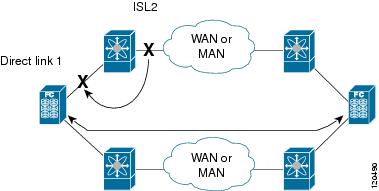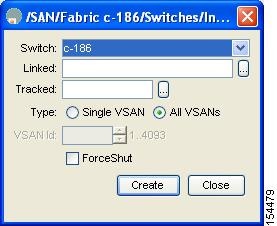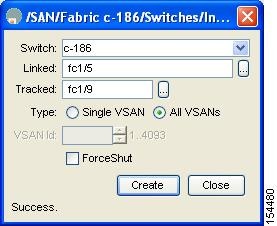- Preface
- Product Overview
- Installing Cisco Fabric Manager
- Fabric Manager Server
- Authentication in Fabric Manager
- Fabric Manager Client
- Device Manager
- Using Cisco Fabric Services
- Configuring Ethernet Interfaces
- Configuring Virtual Interfaces
- Configuring Fibre Channel Interfaces
- Configuring N-Port Virtualization
- Configuring Domain Parameters
- Configuring VSAN Trunking
- Configuring and Managing VSANs
- Configuring and Managing Zones
- Distributing Device Alias Services
- Configuring Fibre Channel Routing Services and Protocols
- Managing FLOGI, Name Server, FDMI, and RSCN Databases
- Configuring SPAN
- Discovering SCSI Targets
- Configuring SAN PortChannels
- Advanced Features and Concepts
- Configuring FC-SP and DHCHAP
- Configuring Port Security
- Configuring Fabric Binding
- Configuring Fabric Configuration Servers
- Configuring Port Tracking
- Network Monitoring
- Performance Manager
- Nexus 5000 Management Software FAQ
- Troubleshooting Your Fabric
- Index
Configuring Port Tracking
Cisco Nexus 5000 Series switches offer the port tracking feature on physical Fibre Channel interfaces (but not on virtual Fibre Channel interfaces). This feature uses information about the operational state of the link to initiate a failure in the link that connects the edge device. This process of converting the indirect failure to a direct failure triggers a faster recovery process towards redundant links. When enabled, the port tracking feature brings down the configured links based on the failed link and forces the traffic to be redirected to another redundant link.
This chapter includes the following sections:
•![]() Information About Port Tracking
Information About Port Tracking
•![]() Default Port Tracking Settings
Default Port Tracking Settings
Information About Port Tracking
Generally, hosts can instantly recover from a link failure on a link that is immediately (direct link) connected to a switch. However, recovering from an indirect link failure between switches in a WAN or MAN fabric with a keepalive mechanism is dependent on several factors such as the timeout values (TOVs) and on registered state change notification (RSCN) information (see the "Fibre Channel Timeout Values" section on page 22-1 and "About RSCN Information" section on page 19-5).
In Figure 27-1, when the direct link 1 to the host fails, recovery can be immediate. However, when the ISL 2 fails between the two switches, recovery depends on TOVs, RSCNs, and other factors.
Figure 27-1 Traffic Recovery Using Port Tracking

The port tracking feature monitors and detects failures that cause topology changes and brings down the links connecting the attached devices. When you enable this feature and explicitly configure the linked and tracked ports, the switch software monitors the tracked ports and alters the operational state of the linked ports on detecting a link state change.
The following terms are used in this chapter:
•![]() Tracked ports—A port whose operational state is continuously monitored. The operational state of the tracked port is used to alter the operational state of one or more ports. Fibre Channel, VSAN, SAN port channel, or a Gigabit Ethernet port can be tracked. Generally, ports in E and TE port modes can also be F ports.
Tracked ports—A port whose operational state is continuously monitored. The operational state of the tracked port is used to alter the operational state of one or more ports. Fibre Channel, VSAN, SAN port channel, or a Gigabit Ethernet port can be tracked. Generally, ports in E and TE port modes can also be F ports.
•![]() Linked ports—A port whose operational state is altered based on the operational state of the tracked ports. Only physical Fibre Channel ports can be linked ports.
Linked ports—A port whose operational state is altered based on the operational state of the tracked ports. Only physical Fibre Channel ports can be linked ports.
Port tracking has the following features:
•![]() The application brings the linked port down when the tracked port goes down. When the tracked port recovers from the failure and comes back up again, the linked port is also brought up automatically (unless otherwise configured).
The application brings the linked port down when the tracked port goes down. When the tracked port recovers from the failure and comes back up again, the linked port is also brought up automatically (unless otherwise configured).
•![]() You can forcefully continue to keep the linked port down, even though the tracked port comes back up. In this case, you must explicitly bring up the linked port when required.
You can forcefully continue to keep the linked port down, even though the tracked port comes back up. In this case, you must explicitly bring up the linked port when required.
Configuring Port Tracking
Before configuring port tracking, consider the following guidelines:
•![]() Verify that the tracked ports and the linked ports are on the same Cisco switch.
Verify that the tracked ports and the linked ports are on the same Cisco switch.
•![]() Be aware that the linked port is automatically brought down when the tracked port goes down.
Be aware that the linked port is automatically brought down when the tracked port goes down.
•![]() Do not track a linked port back to itself (for example, Port fc2/2 to Port fc2/4 and back to Port fc2/2) to avoid recursive dependency.
Do not track a linked port back to itself (for example, Port fc2/2 to Port fc2/4 and back to Port fc2/2) to avoid recursive dependency.
This section includes the following topics:
•![]() About Configuring Linked Ports
About Configuring Linked Ports
•![]() Operationally Binding a Tracked Port
Operationally Binding a Tracked Port
•![]() About Tracking Multiple Ports
About Tracking Multiple Ports
•![]() About Monitoring Ports in a VSAN
About Monitoring Ports in a VSAN
•![]() Forcefully Shutting Down a Tracked Port
Forcefully Shutting Down a Tracked Port
Enabling Port Tracking
The port tracking feature is disabled by default in Cisco Nexus 5000 Series switches. When you enable this feature, port tracking is globally enabled for the entire switch.
To configure port tracking, enable the port tracking feature and configure the linked ports for the tracked port.
To enable port tracking with Fabric Manager, perform this task:
Step 1 ![]() In the Physical Attributes pane, expand Switches > Interfaces, and then choose Port Tracking
In the Physical Attributes pane, expand Switches > Interfaces, and then choose Port Tracking
The port tracking information is displayed in the Information pane as shown in Figure 27-2. The default tab is the Controls tab.
Figure 27-2 Port Tracking

Step 2 ![]() In the Command column, choose enable or disable for the port tracking.
In the Command column, choose enable or disable for the port tracking.
Depending on your selection the corresponding entry in the Status column changes.
Step 3 ![]() Click the Apply Changes icon to save your changes.
Click the Apply Changes icon to save your changes.
The entry in the Result column changes to success.
About Configuring Linked Ports
You can link ports using one of two methods:
•![]() Operationally binding the linked ports to the tracked port (default).
Operationally binding the linked ports to the tracked port (default).
•![]() Continuing to keep the linked port down forcefully, even if the tracked port has recovered from the link failure.
Continuing to keep the linked port down forcefully, even if the tracked port has recovered from the link failure.
Operationally Binding a Tracked Port
When you configure the first tracked port, operational binding is automatically in effect. When you use this method, you have the option to monitor multiple ports or monitor ports in one VSAN.
To operationally bind a tracked port, perform this task:
Step 1 ![]() In the Physical Attributes pane, expand Switches > Interfaces, and then choose Port Tracking
In the Physical Attributes pane, expand Switches > Interfaces, and then choose Port Tracking
The port tracking information is displayed in the Information pane. The default tab is the Controls tab.
Figure 27-3 Port Tracking Controls Tab

Step 2 ![]() Click the Dependencies tab.
Click the Dependencies tab.
Step 3 ![]() Click Create Row.
Click Create Row.
You see the Create Port Tracking Dependencies dialog box as shown in Figure 27-4.
Figure 27-4 Create Port Tracking Dependencies Dialog Box

Step 4 ![]() Select the switch whose ports you want to track by choosing a switch from the drop-down list.
Select the switch whose ports you want to track by choosing a switch from the drop-down list.
Step 5 ![]() Select the linked ports that should be bound to the tracked ports by clicking the browse button and choosing from the list.
Select the linked ports that should be bound to the tracked ports by clicking the browse button and choosing from the list.
Step 6 ![]() Click the Single VSAN radio button if you want to track these ports only in one VSAN or click the All VSANs radio button if you want to track these ports in all the available VSANs.
Click the Single VSAN radio button if you want to track these ports only in one VSAN or click the All VSANs radio button if you want to track these ports in all the available VSANs.
See "About Monitoring Ports in a VSAN" section for details.
Step 7 ![]() If you chose Single VSAN in the previous step, enter the ID of the VSAN where these ports will be monitored.
If you chose Single VSAN in the previous step, enter the ID of the VSAN where these ports will be monitored.
Step 8 ![]() Check the Forceshut check box if you want to forcefully shut down the tracked port.
Check the Forceshut check box if you want to forcefully shut down the tracked port.
See "About Forceful Shutdown" section for details.
Step 9 ![]() Click Create to proceed with creating this dependency.
Click Create to proceed with creating this dependency.
If tracking is established, you see Success in the lower left corner of the dialog box as shown in Figure 27-5.
Figure 27-5 Successful Port Tracking Established

Step 10 ![]() Click Close to close the dialog box.
Click Close to close the dialog box.
The following example shows how to enable port tracking for specific interfaces:
switch# configure
switch(config)# interface fc 2/4
switch(config-if)# port-track interface san-port-channel 2
About Tracking Multiple Ports
You can control the operational state of the linked port based on the operational states of multiple tracked ports. When more than one tracked port is associated with a linked port, the operational state of the linked port will be set to down only if all the associated tracked ports are down. Even if one tracked port is up, the linked port will stay up.
In Figure 27-6, only if both ISLs 2 and 3 fail, will the direct link 1 be brought down. Direct link 1 will not be brought down if either 2 or 3 are still functioning as desired.
Figure 27-6 Traffic Recovery Using Port Tracking

Tracking Multiple Ports
To track multiple ports, see the "Operationally Binding a Tracked Port" section.
The following example shows how to enable port tracking for multiple interfaces:
switch# configure
switch(config)# interface fc 2/3
switch(config-if)# port-track interface fc 2/3
switch(config-if)# port-track interface san-port-channel 2
About Monitoring Ports in a VSAN
You can optionally configure one VSAN from the set of all operational VSANs on the tracked port with the linked port by specifying the required VSAN. This level of flexibility provides higher granularity in tracked ports. In some cases, when a tracked port is a TE port, the set of operational VSANs on the port can change dynamically without bringing down the operational state of the port. In such cases, the port VSAN of the linked port can be monitored on the set of operational VSANs on the tracked port.
If you configure this feature, the linked port is up only when the VSAN is up on the tracked port.

Tip ![]() The specified VSAN does not have to be the same as the port VSAN of the linked port.
The specified VSAN does not have to be the same as the port VSAN of the linked port.
Monitoring Ports in a VSAN
To monitor a tracked port in a specific VSAN, see "Operationally Binding a Tracked Port" section.
About Forceful Shutdown
If a tracked port flaps frequently, then tracking ports using the operational binding feature may cause frequent topology change. In this case, you may choose to keep the port in the down state until you are able to resolve the reason for these frequent flaps. Keeping the flapping port in the down state forces the traffic to flow through the redundant path until the primary tracked port problems are resolved. When the problems are resolved and the tracked port is back up, you can explicitly enable the interface.

Tip ![]() If you configure this feature, the linked port continues to remain in the shutdown state even after the tracked port comes back up. You must explicitly remove the forced shut state (by administratively bringing up this interface) of the linked port once the tracked port is up and stable.
If you configure this feature, the linked port continues to remain in the shutdown state even after the tracked port comes back up. You must explicitly remove the forced shut state (by administratively bringing up this interface) of the linked port once the tracked port is up and stable.
Forcefully Shutting Down a Tracked Port
To forcefully shut down a tracked port, see "Operationally Binding a Tracked Port" section.
Default Port Tracking Settings
Table 27-1 lists the default settings for port tracking parameters.
|
|
|
|---|---|
Port tracking |
Disabled |
Operational binding |
Enabled along with port tracking |
 Feedback
Feedback